These AP 10th Class Biology Important Questions and Answers 7th Lesson Coordination in Life Processes will help students prepare well for the exams.
AP State Syllabus 10th Class Biology 7th Lesson Important Questions and Answers Coordination in Life Processes
10th Class Biology 7th Lesson Coordination in Life Processes 1 Mark Important Questions and Answers
Question 1.
Complete the following table.
Answer:
Question 2.
What is the apparatus used in your class, while performing the demonstration of peristaltic movement in Oesophagus?
Answer:
a) A piece of waste cycle tube.
b) Oil for lubrication.
c) Potatoes.
![]()
Question 3.
You have conducted an experiment to prove that HC1 secreted in our stomach, does not harm walls of the stomach. Write the apparatus used in that experiment.
Answer:
Apparatus: Green leaves, petroleum jelly, weak acid.
Question 4.
What will happen, if there is no diaphragm in the human body?
Answer:
- Diaphragm flattens during inhalation, thus increasing the volume of the thoracic cavity.
- If the diaphragm is absent the inhalation and exhalation become very difficult in human beings.
Question 5.
What happens if the direction of peristalsis is not reversed in animal like cow?
Answer:
If the direction of peristalsis is not reversed (rumination is not done) in animal like cow, the food will not be masticated in the mouth and fermentation of the food with the micro-organisms in the stomach will not be taken place.
![]()
Question 6.
What happens if there is no mucus in the Oesophagus?
Answer:
- The walls of the food pipe secrete a slippery substance called mucus.
- Mucus lubricates and protects the oesophageal walls from damage.
- This helps the food bolus to slide down easily in the tube.
- If there is no mucus, lubrication will not occur for the food bolus to slide and walls get damage.
Question 7.
Which part of small intestine absorbs digested food?
Answer:
Microvilli/villi.
Question 8.
Name the chemical which is used to test the action of saliva on flour (ata).
Answer:
Iodine Solution.
Question 9.
What happens, if there is no peristaltic movement in Oesophagus?
Answer:
- The food won’t slidedown in the oesophagus.
- The digestion of food won’t takes place in the stomach and small intestine.
Question 10.
Number of Neurons present in enteric Nervous System?
Answer:
Number of neurons present in enteric nervous system are 100 millions.
Question 11.
Why do every life process is dependent on other life process?
Answer:
Every life process is dependent on other life process to keep the body in good condition.
![]()
Question 12.
Which life process generally maintain the level of different substances in the blood?
Answer:
The life process that maintain the level of different substances in the blood is digestive system.
Question 13.
When do we feel hunger pangs in stomach?
Answer:
When the level of glucose in the blood falls we feel hunger pangs in stomach.
Question 14.
Which hormone is responsible for hunger pangs in stomach?
Answer:
Ghrelin hormone is responsible for hunger pangs in stomach.
Question 15.
The hormone ghrelin is secreted by?
Answer:
The hormone ghrelin is secreted by certain cells in the wall of the stomach.
Question 16.
Which one plays an important role in carrying hunger signals to brain?
Answer:
The diencephalon in fore brain and vagus nerve which is 10th cranial nerve plays an important role in carrying hunger pangs.
Question 17.
How much time does the hunger pangs continue?
Answer:
The hunger pangs continue up to 30 to 45 minutes.
Question 18.
Increase in ghrelin levels results in?
Answer:
Increase in ghrelin levels results in sensation of hunger and motivation to consume food.
![]()
Question 19.
Which hormone suppresses hunger?
Answer:
Hormone leptin suppresses hunger.
Question 20.
Which senses enhance our perceptions of the food we eat?
Answer:
Interactions between the senses of taste and smell enhance our perceptions of the food we eat.
Question 21.
What are the different types of papillae present on the tongue?
Answer:
The different types of papillae present on the tongue are filiform papillae, fungiform papillae, foliate papillae and circumvallate papillae.
Question 22.
When do you identify the taste easily?
Answer:
Taste can be identified easily by me when the tongue is pressed against the pallate.
Question 23.
Who conducted experiments on conditioned reflexes?
Answer:
Russian scientist Ivan Pavlov has conducted experiments on conditioned reflexes and found that even the thought of food will water our mouth.
Question 24.
Name the different sets of teeth present in your mouth.
Answer:
The different sets of teeth present in human beings is incisors, canines, premolars and molars.
Question 25.
Write the number of different sets of teeth in human Beings.
Answer:
The number of different sets of teeth in human beings are incisors – 8, canines – 4, premolars – 8, molars -12.
![]()
Question 26.
What is mastication?
Answer:
Grinding, chewing and shredding of food in the mouth by teeth is called mastication.
Question 27.
Which cranial nerve controls the movement of a muscle in the jaw?
Answer:
The fifth cranial nerve (Trigeminal nerve) controls the movement of muscles in the jaw.
Question 28.
What is bolus?
Answer:
Food that is formed due to the mastication in the mouth is called bolus.
Question 29.
What is the function of salivary amylase?
Answer:
The enzyme salivary amylase in the saliva breaks down the large starch molecules into smaller subunits usually into sugars.
Question 30.
The controlling center for swallowing food is present in?
Answer:
The controlling center for swallowing food is present somewhere in the brain stem „ (medulla oblongata and others).
Question 31.
Which medium aids in action of enzyme, salivary amylase?
Answer:
Alkaline medium aids in action of enzyme, salivary amylase.
Question 32.
The pH value of alkaline medium is?
Answer:
The pH value of alkaline medium is above 7.
![]()
Question 33.
The pH value of acidic medium is?
Answer:
The pH value of acidic medium is below 7.
Question 34.
What are nocturnal animals? Give some examples.
Answer:
The animals which are active during nights are called Nocturnal animals.
Ex: Cockroach, rodents, bats etc.
Question 35.
The amount of saliva secreted by human beings per day is?
Answer:
The amount of saliva secreted by human beings per day is 1 to 1.5 liters.
Question 36.
What kind of tube is oesophagus?
Answer:
Oesophagus is muscular and elastic tube.
Question 37.
How does mucus help in passage of food?
Answer:
Mucus lubricates, protects the walls from damage and helps bolus slide down easily to stomach.
Question 38.
What are the two kinds of smooth muscles present in oesophagus?
Answer:
The two kinds of smooth muscles present in oesophagus are the inner layer consists of circular muscles and the outer layer of longitudinal muscles.
Question 39.
What is peristalsis?
Answer:
The involuntary contraction and relaxation of the muscles of oesophagus, stomach and intestine bring in a wave like motion called peristalsis.
![]()
Question 40.
APiich nervous system controls the peristalsis?
Answer:
The involuntary movements peristalsis is under the control of autonomous nervous system.
Question 41.
Which juice is secreted by the wall of stomach?
Answer:
The juice secreted by the wall of stomach is gastric juice which contains hydrochloric acid, mucus and enzyme pepsin.
Question 42.
What is chyme?
Answer:
The digestive juices turns the food into a smooth substance known as chyme. It is the partially digested food in the stomach.
Question 43.
Rumination in cow is the result of?
Answer:
Rumination in cow is the result of reverse peristalsis.
Question 44.
What is the use of reverse peristalsis in human beings?
Answer:
The use of reverse peristalsis in human beings helps in vomiting, (expelling unwanted substances from the food canal.)
![]()
Question 45.
How much time does it takes to emptying the food from stomach?
Answer:
Emptying of food from stomach takes nearly 4 to 5 hours.
Question 46.
What causes the stomach to churn and mix the food?
Answer:
Peristalsis causes the stomach to churn and mix the food.
Question 47.
What issthe location of pyloric sphincter? What is its function?
Answer:
Pyloric sphincter present at the opening of stomach and the first part of the small intestine. It releases small quantity of food into the duodenum.
Question 48.
Why should only a small quantity of food be passed from stomach to duodenum?
Answer:
For the complete digestion of the food only a small quantity of food be passed from stomach to duodenum.
Question 49.
What is the nature of the chyme?
Answer:
The nature of the chyme is acidic.
Question 50.
Which hormones in small intestine produced due to the Acidic nature of chyme?
Answer:
Acidic nature of chyme initiates the production of hormones like secretin and cholecystokinin in small intestine.
![]()
Question 51.
Secretin and cholecystokinin stimulates the production of?
Answer:
Secretin and cholecystokinin stimulates the production of pancreatic juice, bile juice and succus entericus from pancreas, liver and walls of intestine respectively.
Question 52.
Which process is involved in absorption of nutrients from food?
Answer:
Selective absorption is involved in absorbing nutrients from food.
Question 53.
Which absorb nutrients from the food in small intestine?
Answer:
Finger-like projections called villi absorb nutrients from the food in small intestine.
Question 54.
Anyone with severe cough and cold cannot make out the difference in tastes of certain food items, when the sense of smell is impaired. Why?
Answer:
- The flavour of food is produced with the combination of taste and smell.
- The taste or food odour is not individually detected.
- The interactions between the senses of taste and smell enhance our perceptions of the food.
Question 55.
Seventy percent of our immune system is aimed at?
Answer:
Seventy percent of our immune system is aimed at the gut (elementary canal) to expel and kill foreign invaders.
![]()
Question 56.
What is the second brain?
Answer:
The entric nervous system present below the gut or alimentary canal which controls digestion is called second brain.
Question 57.
What is the other name for second brain?
Answer:
The other name for second brain is enteric nervous system.
Question 58.
What is the length of gut or alimentary canal?
Answer:
The length of gut or alimentary canal in man measures about nine meters.
Question 59.
Which part or muscle controls the exit of stool from the body?
Answer:
Anal sphincter controls the exit of stool from the body.
Question 60.
What happens during inhalation?
Answer:
During inhalation oxygen moves across the walls of the alveoli and enters the blood.
![]()
Question 61.
What happens during exhalation?
Answer:
During exhalation, carbon dioxide from the blood moves into the alveoli of the lungs and breathed out.
Question 62.
What would be the path of salt removal from gut to the outside of our body?
Answer:
Salt is removed via blood through the kidneys, skin from our body.
Question 63.
Respiration in human beings is controlled by?
Answer:
Respiration in human beings is controlled by medulla oblongata of the autonomous nervous system.
![]()
Question 64.
For oxidation of food and transport of substance which processes are to be coordinated?
Answer:
Respiration and blood circulations are to be coordinated for oxidation of food and transport of substances.
10th Class Biology 7th Lesson Coordination in Life Processes 2 Marks Important Questions and Answers
Question 1.
The mere smell or sight of food stimulates hunger. Describe the process in a flow chart.
Answer:
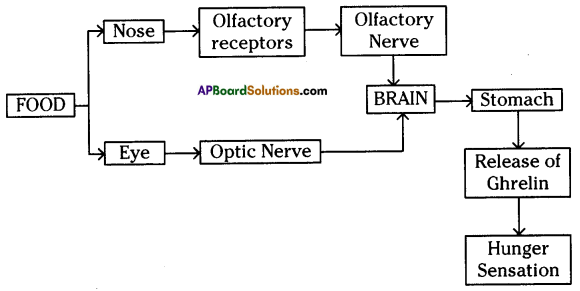
Question 2.
What happens if salivary ducts are closed?
Answer:
- Salivary glands secrete saliva. Saliva contains mucin and ptyalin or salivary amylase.
- Mucin gives lubrication to the bolus so that we can easily swallow the food.
- Ptyalin or salivary amylase digest the complex carbohydrates into simple sugars.
- If salivary ducts are closed the above processess don’t occur. So that food is not digested properly.
![]()
Question 3.
“It is believed that the Diencephalon in fore-brain and vagus nerve (10th cranial nerve) plays an important role in carrying hunger signals to the brain. Hunger pangs continue upto 30-45 minutes. Increase in ghrelin levels results in sensation of hunger and motivation to consume minutes. Increase in ghrelin levels results in sensation of hunger and motivation to consume food.
Read above content and prepare any two questions.
Answer:
- What are the nerves involved in carrying hunger signals?
- How long hunger pangs continue?
- Which part of the brain is the centre for hunger pangs?
- Which chemical substance is responsible for motivating to consume food?
- What are the hormones related to hunger?
Question 4.
What will happen, if the small intestine is not like a long coiled tube?
Answer:
- If size and shape of small intestine is like oesophagus the height of the person should be more than 22 feet as the length of the small intestine is about 22 feet. So it will not fit in the human body.
- Food will not be digested completely.
- Digested food will not be absorbed effectively.
- The food taken into the body is expelled out only after completing partial digestion in stomach.
- The body suffers from starvation of nutrients.
Question 5.
What did you observe in acid and leaf experiment ? What did you have understand regarding human digestive system from this? (OR)
Take two similar green leaves. Apply grease on one leaf and leave the other free. Add 1 or 2 drops of acid on each leaf. What kind of change do you observe from this?
Answer:
- The leaf to which grease is applied is not effected with the acid.
- The leaf to which grease is not applied is effected.
- From the above activity we can conclude that mucus secreted by the walls of stomach protect it from the harmful effects of hydrochloric acid in the stomach.
![]()
Question 6.
Identify the diagram and write two functions of it.
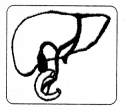 Answer:
Answer:
This diagram is Liver.
Liver – Functions:
- Breakdown of larger fats into small globules/emulsification of fats.
- It excretes Bile salts, cholesterol steroid, hormones, extra drugs, vitamins and alkaline salts through urine.
Question 7.
What will happen if Islets of langerhans fail to function?
Answer:
- Insulin may not be produced.
- Human may suffer from sugar/diabetes.
- Sugar level increases in blood.
![]()
Question 8.
What may happen if villi are absent in small intestine?
Answer:
- Villi increase the surface area of the small intestine for absorption when food passes through it. If villi are absent, food will not be digested completely.
- Digested food will not be absorbed effectively.
- The food taken into the body is expelled out only after completing partial absorption in the small intestine.
- The body will suffer from starvation of nutrients.
Question 9.
Draw the diagram showing peristaltic movement. Write the names of the parts responsible for it.
Answer:
a) Mucus lubricates and protects the walls of oesophagus.
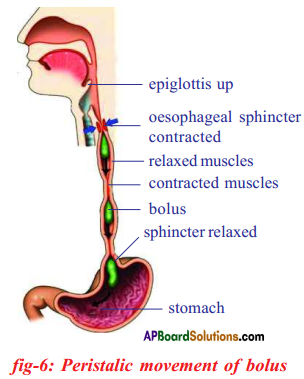 b) Circular muscles and longitudinal muscles of oesophagus help in the movement of food ‘bolus’.
b) Circular muscles and longitudinal muscles of oesophagus help in the movement of food ‘bolus’.
c) Peristalsis is under the control of Autonomous nervous system.
![]()
Question 10.
How do we know the taste of the food material? (OR)
What helps us in tasting food material?
Answer:
- On the tongue different types of papillae are present to sense different tastes.
- If we want to taste the food material, the food should be dissolved in saliva.
- We can taste the food that is in the form of liquid only.
- Only after the dissolved food enters into the cup like taste buds (papillae), the sense of taste is carried to the brain for analysis.
- Then only we will know the taste of the food material.
Question 11.
Write a short note on digestion of food in mouth.
(OR)
How food is digested in the mouth?
Answer:
- Saliva is secreted by the action of autonomous nervous system in the mouth.
- Saliva moistens the food to make chewing and swallowing easier.
- Due to the mastication of food in the mouth it forms a slurry mass called bolus.
- The enzyme salivary amylase in the saliva breaks down the large starch molecules into smaller subunits usually into sugars of maltose and dextrose.
- It is easier and convenient to swallow food after mastication in the mouth.
Question 12.
Why do we salivate during a nap of daytime?
Answer:
- We are diurnal animals, we are active during daytime and take rest at night.
- Ail the systems of our body are active in function during the daytime of our activity. Hence, man is a diurnal animal.
- Our digestive system is also active and ready to receive the food for digestion.
- If we sleep during daytime saliva oozes out of our mouth and wets the pillows.
- This will not happen during night time.
![]()
Question 13.
Write a brief account on travel of food through oesophagus.
(OR)
How food travels in the oesophagus?
Answer:
- Oesophagus is a tube like structure.
- the wall of the oesophagus is made up of two kinds of smooth muscles.
- The inner layer consisting of circular muscles and the outer layer with longitudinal muscles.
- Contraction of the circular muscles results in narrowing of the oesophagus just behind the bolus. So the food is squeezed downwards.
- Contraction of the longitudinal muscles in front of the bolus widen the tube, this results in shortening of that particular part of the oesophagus.
- Contraction and relaxation of these muscles bring in a wave like motion that propels the food bolus into the stomach by ‘peristalsis’.
Question 14.
The digestive tract is unique among internal organs. Write few lines by supporting this statement.
Answer:
- The digestive tract is unique among internal organs because it is exposed to a large variety of physio chemical stimuli from the external world in the form of ingested food.
- As a consequence, the intestine has developed a rich store of coordinated movements of its muscular apparatus along with neural apparatus to ensure the appropriate mixing and propulsion of contents during digestion, absorption and excretion.
- The neural apparatus of our digestive tract comprises of such a vast and complicated network of neurons that it has been nicknamed by scientists as the second brain.
![]()
Question 15.
How taste is identified by us? (OR) How can we identify taste?
Answer:
- Any food substance when placed on the tongue gets dissolved in the saliva secreted by salivary glands in the mouth.
- When the tongue is pressed against the palate the food substance is pressed against the opening of the taste bud letting it to reach the taste cells and triggering taste signals.
- Finally the taste is recognized in the brain.
10th Class Biology 7th Lesson Coordination in Life Processes 4 Marks Important Questions and Answers
Question 1.
Give reasons:
A) Hunger generating signals reach the brain when stomach gets empty.
Answer:
Ghrelin is secreted from walls of the stomach.
B) When your stomach is filled with full of food, you feel you don’t need food any more.
Answer:
Leptin Hormone is secreted which suppresses hunger.
C) In severe cold and cough, one cannot feel the taste of the food.
Answer:
During cold olfactory receptors are blocked.
D) We cannot identify the taste of a grape fruit, when it is placed on the tongue.
Answer:
We cannot taste the grapes because it is not in the liquid state.
![]()
Question 2.
A) What is the function of peristalsis in these parts of Human digestive system?
a) Oesophagus
b) Stomach
c) Small intestine
d) Large intestine
Answer:
a) Oesophagus: Bolus moves towards the stomach.
b) Stomach : Peristalsis helps in storing food, breaking down food, mixing the food with gastric juice.
c) Small intestine : Peristalsis helps in mixing the chyme with digestive juices.
d) Large intestine: Peristalsis helps to propel undigested material into rectum.
Question 3.
Observe the following schematic diagram and answer the following questions:

i) What do you call the wave like movements shown by the muscles of Oesophagus?
Answer:
Peristalsis.
ii) What is the structure of Oesophagus?
Answer:
Long tube like structure.
iii) How does mucus help in passage of food?
Answer:
Mucus helps the food to slide down easily.
iv) Which parts of alimentary canal are connected by the Oesophagus?
Answer:
Pharynx and stomach.
![]()
Question 4.
What is peristaltic movement? Compare the similarity of bolus movement in oesophagus with cycle tube and potato experiment which you have conducted in school.
Answer:
Peristalsis: Contraction and relaxation of circular and longitudinal muscles bring in a wave – like motion that propels the food bolus into the stomach from oesophagus by the action called as peristalsis.
Experiment:
Aim: Making a model of oesophagus to observe how bolus moves forward.
Material required: Potatoes, cycle tube lubricate oil.
 Procedure:
Procedure:
- Take a piece of waste cycle tube and insert one or two potatoes into it.
- Lubricate the inner side of the tube with oil.
- In the same way smear oil over potatoes.
- Insert oil coated potatoes in the tube. Potatoes in cycle tube
- Now try to push the potatoes by squeezing the tube from behind the potato.
Observation: Oil acted as lubricant to push the potato easily in the forward direction. Conclusion: The muscles in the wall of the oesophagus have bring in a wave like movement due to contraction and relaxation, that propels the food bolus into the stomach.
This action is called as peristalsis.
![]()
Question 5.
Write the procedure involved in the acid and leaf experiment to understand the concept “how the stomach gets protected from its own acid secretions”. Compare the observations with the changes that takes place in human digestive system.
Answer:
- Take two similar green leaves.
- Grease one leaf with petroleum jelly, leave the other free.
- Add 1 or 2 drops of some weak acids on both the leaves.
- Observe them after half-an-hour or so and write your observations.
- The leaf to which petroleum jelly was not applied effected by the acid.
- We observe the colour of the leaf changes.
- The other leaf was not affected by the acid because of petroleum jelly.
From the above activity we can conclude that mucus secreted by the walls of stomach protects the stomach it from the harmful effects of hydrochloric acid.
Question 6.
Vasu is doing experiment, lab activities in his classroom. He is tired due to hungry. How hungry feeling occurs? How will one know?
Answer:
- Levels of different substances are generally maintained in the blood mainly by our digestive system.
- One of the major substance is glucose.
- When its levels in the blood fall, we get hunger pangs in stomach.
- Ghrelin is secreted from the certain cells in the wall of the stomach.
- Hunger contractions (hunger pangs) start to occur in the stomach due to the secretion of Ghrelin hormone.
- Increase in ghrelin levels results in sensation of hunger and motivation to consume
Question 7.
What is peristaltic movement? Explain the food movement in alimentary canal comparing with the experiment of moving potatoes in cycle tube.
Answer:
Peristaltic movement is the contraction and relaxation of the muscles of the digestive system. The movement of food through food pipe is known as peristaltic movement.
Food movement in alimentary canal:
- The walls of the food pipe secrete a slippery substance called mucus. Mucus lubricates and protects the oesophageal walls from damage.
- This helps the food bolus to slide down easily just as the oiled potatoes that move in the tube. Oil acts as lubricant and push the potatoes easily in the forward direction.
- The wall of the oesophagus is made up of two kinds of smooth muscles. The inner layer consists of circular muscles and the outer layer of longitudinal muscles.
- Contraction of the circular muscles results in narrowing of the oesophagus just behind the bolus.
- So the food is squeezed downwards.
- Contraction of the longitudinal muscles in front of the bolus widen the tube, this results in shortening of that particular part of the oesophagus.
- Contraction and relaxation of these muscles bring in wave like motion that propels the food bolus into the stomach by the action called as peristalsis.
- This is involuntary and under the control of autonomous nervous system.
![]()
Question 8.
Write briefly about the functional and structural aspects of oesophagus in human beings.
Answer:
- Oesophagus is a long muscular and elastic tube-like part of the digestive system which lies between pharynx and stomach.

- The wall of the oesophagus is made up of two kinds of smooth muscles.
- The inner layer consists of circular muscles and the outer layer of longitudinal muscles.
- The walls of the oesophagus secrete mucus, a slimy substance which helps in the easy movement of food into the stomach.
- Walls of oesophagus carry on wave-like movement by contraction and relaxation. These movements are known as peristalsis.
- Due to the peristalsis movements food passes from oesophagus into stomach.
![]()
Question 9.
Explain briefly about the structure of stomach. (OR)
What is the role of stomach in digestion of food ?
Answer:
- Our stomach is not a bag with specific volume. It is a like a pouch which is elastic in nature.
- The size of the stomach increases based on the food we intake.
- Digestive juices are produced depending on the quantity of food material.
- The walls of the stomach secrete juice containing hydrochloric acid.
- Mucus secreted by some cells in the walls of the stomach form a thin lining on the walls of the stomach. This counters the action of acid.
- The food is thoroughly mixed with the digestive juices by peristaltic movements of muscles in stomach.
- The digestive juices of the stomach turns food into a smooth liquid mass called chyme.
Question 10.
Draw peristaltic movement of food in stomach. Describe movement of food in stomach.
Answer:
- The stomach acts like a washing machine, churning the food around to break it into even smaller pieces.

- Mechanical mixing of food in stomach occurs by peristalsis, which is waves of muscular contractions that move along the stomach wall.
- The contractions of the stomach muscles squeeze and mix the food with the acids and juices of the stomach.
- The digestive juices turns the food into smooth paste like substance called chyme.
- As the process of digestion in the stomach nears completion, the contractions of the stomach decrease.
![]()
Question 11.
Describe with diagram how villi are helpful in absorption of digested food in small intestine.
(OR)
How digested food is absorbed in small intestine?
Answer:
- The small intestine is the main region for the absorption of digested food.
- The inner surface of the small intestine contains thousands of finger like projections called Villi.
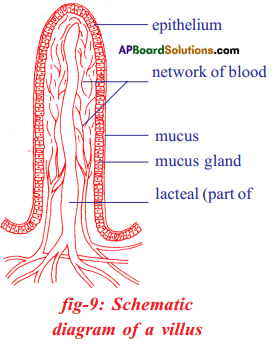
- These villi increase the surface area;so that the food retained in the folds can remain longer thereby enhancing absorption.
- Blood vessels and lymph vessels are present in the form of a network in the villi.
- Products of digestion are absorbed first into the villi and from there into the blood vessels and lymph vessels.
Question 12.
Write about the experiment conducted by Ivan Pavlov on conditioned reflex.
Answer:
- Ivan Pavlov was a Russian scientist conducted experiments on conditioned reflexes.
- He discovered that dogs produced extra saliva when they were offered food.

- Pavlov noticed, that they also did the same when the person who fed them came into the room, even if the person had not brought any food.
- Pavlov went on to ring a bell at the start of feeding time, and eventually the dogs produced extra saliva when they heard the bell, before any food was brought.
- A dog salivating when it hears a bell is not a natural response.
- They would not do this without being conditioned to do so.
- The behaviour has been learned. It is called a conditioned response.
![]()
Question 13.
Explain the process of exit of waste materials from large intestine.
Answer:
- When the unwanted waste material reach the large intestine, the peristaltic waves move the stool into the rectum.
- Water gets reabsorbed and the remaining waste usually hard mass that gets stored in the last part of the large intestine i.e., rectum.
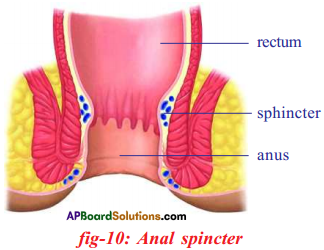
- There are two muscular layers helping the exit of stools.
- One that is under involuntary control and the other is under voluntary control.
- The muscular structures helps in opening and closing of the aperture of a canal is called sphincter.
- Anal sphincter controls the process of exit of waste materials from large intestine.
![]()
